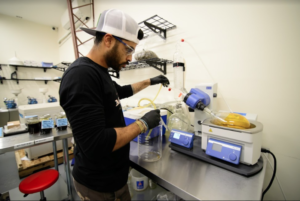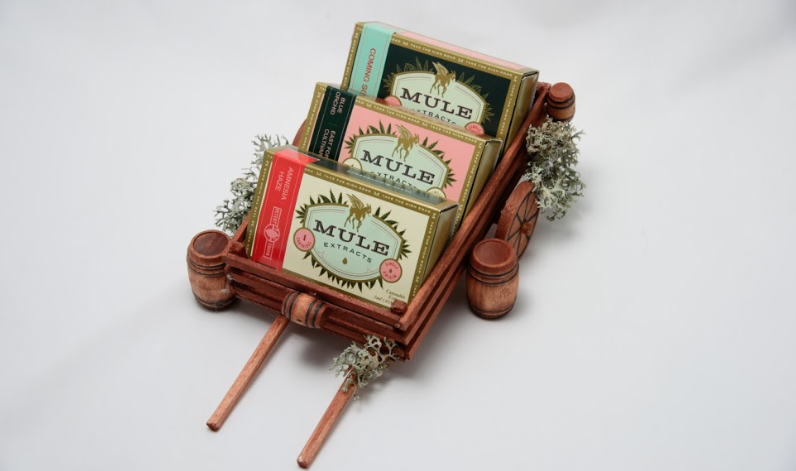An education sesh with Mule Extracts
What’s in a flavor?
As many a cartridge enthusiast can attest, the aromatic integrity of cannabis concentrate often falls short of its flower form.
Unfortunately, there are a lot of extractors out there who struggle to preserve the full range of flavor compounds in fresh bud. Many introduce additional flavorings and contrived terpene ratios, throwing off both the balance and the integrity of the product. Luckily, our concentrate buyer Ben knows where to find the best in craft cannabis cartridges. And we the staff can attest that Mule Extracts, an Estacada-based craft CO2 extraction company, has flavor retention down to a science.
In one of our most memorable staff education “EDU” sessions, Mule’s Kyle and Kevin came to Farma to chat with us about how they do it. We learned about essential oils, olfaction, extraction, and the fascinating complexity of it all.
The psychology of smell and taste
There is a psychological component to our experience of smell and flavor, two of our most important and intricately connected senses. That’s because our olfactory (sense of smell) system is connected to our limbic system, which is responsible for mediating emotions, behaviors, and memory. In fact, it’s the only sense that isn’t mirrored, but directly connected to the brain and the one most deeply associated with memory.
The taste of cannabis during inhalation is critical to our experience of the plant; but the wafting aroma from the dispensary jar might be just as important: “There’s much more to the sensory experience of cannabis than just terpenes,” said Kyle, resident chemical engineer and Mule’s director of product development.
In reality, there’s an entire orchestra of compounds that contribute to a strain’s aroma and flavor profile, and each one is totally unique (hence the incomprehensibly massive amount of distinct cannabis chemotypes). Colloquially known as essential oils, every strain has its own individual blend– like an aromatic fingerprint. The combination of these aroma compounds with cannabinoids is what gives a distinct characteristic to a strain’s high–and its therapeutic effects.
While western medicine is still waking up to their potential medical value, there is some research out there that suggests essential oil therapy (aromatherapy) might be a thing for a reason (take this study for instance, which showed that inhaling lavender oil after surgery could help with pain) – notably demonstrating a distinctly analgesic effect. Could it “just” be placebo? And would that make it any less effective? We’re gonna need more studies to know for sure, but hey, if it works, it works.
Essential oils vs. terpenes: are they the same thing?

Kyle Farook, Mule’s director of operations at work in the lab.
Nope. Essential oils are comprised of two types of potently aromatic chemical compounds: terpenes (hydrocarbons) make up about 80%-90%, and volatile oxygenated compounds (also called VOC’s; such as benzines, phenols, esters, ketones and alkyls) make up the remaining 20%-10%. So, while terpenes are a crucial component of essential oils, an isolated terpene does not an essential oil make.
Terpenes are the more stable part of the essential oil fraction, although they’re still relatively volatile. A number of terps can be captured and retained during conventional CO2 extraction processes and analysis, and some can even survive combustion to give our smoke that delicious flavor. That said, the boiling points of terpenes are highly variable, and many of them will eventually degrade if cannabis is improperly stored– that is, unprotected from air, light and extreme temperatures.
VOC’s, however, are extremely volatile. When exposed to that same air-light-temp trio, they degrade rapidly and are also sensitive to more specific environmental variants like moisture and pressure. Combustion destroys them immediately, and some even degrade at room temperature. They’re so sensitive that they break down during conventional analysis methods like high pressure and gas chromatography– which means labs can’t even test for them in our cannabis (yet).
Why does that suck? Because, according to the guys at Mule, these finicky little compounds are responsible for what is possibly the most important element of smell: sweetness.
Sweetness and nuance
If you’ve interacted with Farma’s Terpene Book, you probably know that lavender has rich concentrations of linalool. And its scent is recognizable: clean, even soapy, with a floral quality and a hint of citrus that immediately opens up the memory bank upon inhalation. It smells a lot like lavender. But the scent of pure linalool is not the same as the scent of lavender essential oil– although it probably still helps us calm down a bit. There is something missing – a richness, a depth. A sweetness.
And, according to Kyle, the smell of sweetness, that distinct sugary quality, cannot be captured by any single terpene— but rather it comes from those VOC’s we mentioned above. Of course, those same sweet smelling molecules can transform into acrid, foul ones when burned. Which might be why cartridges and vaporized flower taste best at lower temperature settings.
There are other terpenes to consider, as well. For example, the typical composition of the characteristic lavender aroma comes from a combination of terpenes: linalool, beta-caryophyllene, ocimene, a-pinene, and beta-caryophyllene, and sweet-providing VOC’s: linalyl acetate, lavandulyl acetate. It is this layered effect, how each compound engages another, that distinguish the scent profiles we associate with the plant. Just like cannabis.
Flavor philosophy and the Mule method
While therapeutic application is important to the folks at Mule, there’s another, more existential (yet still chemical) drive at play in Mule’s philosophy: that is, fine-tuning the effect of flavor on experience and memory.
In an interview with Kyle, he went on to say that, while flavors are inherently subjective, “humans have intense emotional responses to scent and flavor, often times resulting in a memory stimulation unique to each user. When a product is designed for flavor, you are not targeting intoxication or physiological/mental therapy, which are often expected, objectively measurable responses, you are targeting emotion and memory.”
Needless to say, retaining the full spectrum of those sweet, sensitive aromatics in cartridge form is complicated. The key to Mule’s notoriously robust flavor profiles? Fortifying their already full-spectrum CO2 extract with steam-distilled, strain-specific essential oil. Because they’re not trying to make their extracts taste like lavender, they’re trying to make their extracts taste like the plant they came from.
Since distillation is a gentler process, it better captures a wider spectrum of aromatics, including some of those tricky, sweet compounds. Mule even buys extra plant material just for essential oil production, which they do in-house.
The nose knows (for the most part)
What all of this mean for us, the consumers? For starters, there’s more to cannabis’ aroma than just the terpenes. And although we don’t have a way of measuring the levels of those sweet, sensitive VOC’s (yet), there’s no denying that they have a powerful impact on our experience with a strain– before we even smoke it.
So before you light up your next pre-roll, take a few hits before applying any heat: “by puffing on a joint before its even lit, that’s when you get the truest olfactory experience with cannabis,” says Kyle. Then light it up, and see how it changes.
Or, just pick up a vape pen and try a little something by Mule.
Currently at Farma:
Cartridges:
Blue Orchid- A 1:6 CBD-rich, ocimene-dominant cartridge with a ridiculously tasty, floral flavor profile.
Tangie- It’s like a tropical smoothie in vapor form. We’ll keep this one stocked this summer, don’t worry.
Cannabis sugar:
Summer floral cannabis sugar– Made with East Fork’s 1:3 Blue Dynamite, featuring notes of chamomile, orange blossom, and french vanilla.
References
(2011) Composition of lavender oils:
https://www.ncbi.nlm.nih.gov/pubmed/21870761
(2016) Essential Oils’ Chemical Characterization and Investigation of Some Biological Activities: A Critical Review:
https://www.ncbi.nlm.nih.gov/pmc/articles/PMC5456241/
(2018) Inhalation aromatherapy with lavender for pain after surgery:
(2013) Lavender and the nervous system:
https://www.ncbi.nlm.nih.gov/pmc/articles/PMC3612440/
(2011) Olfactory system and emotion: Common substrates:
https://doi.org/10.1016/j.anorl.2010.09.007
(2017) Systematic review of the effectiveness of Aromatherapy on depressive symptoms:
https://www.ncbi.nlm.nih.gov/pmc/articles/PMC5241490/
(2018) Vibrational theory of olfaction:
https://www.frontiersin.org/articles/10.3389/fphy.2018.00025/full#h6

